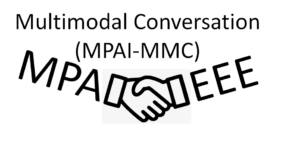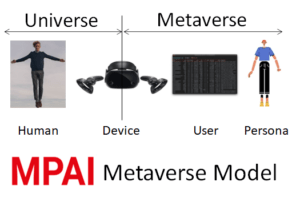The 44th MPAI General Assembly has published three Calls for Technologies. The MPAI Metaverse Model – Technologies. requests parties having rights to technologies satisfying the MMM-TEC Use Cases and Functional Requirements and the MMM-TEC Framework Licence to respond to the Call preferably using the MMM-TEC Template for Responses. An online presentation of this Call will be held on 2024/05/31 (Tuesday) at 15 UTC. Please register, if you wish to attend the presentation (recommended if you intend to respond).
MPAI kicked off the MPAI Metaverse Model (MPAI-MMM) project some 30 months ago. The project has already produced two Technical Reports exploring the field, one on Functionalities and one on Functional Profiles. In September 2023, MPAI published Version 1.0 of Technical Specification: MPAI Metaverse Model (MPAI-MMM) – Architecture (MMM-TEC). This specified the MMM Operation Model, composed of interacting Processes (specifically, Devices, Services, and Users representing humans), exchanging Items (data) and performing Actions on the Items. Two metaverse instances implementing the MMM Operation Model can interoperate – i.e., exchange and perform Actions on Items – if they satisfy the MMM-ARC specified Functional Requirements to enable Conversion Services to overcome possible technology incompatibility.
This is illustrated in Figure 3 where there are three humans (green rectangles) staying outside of an MMM instance and communicating with the MMM instance via Devices located half-way between the real world (universe) and the virtual world (metaverse). Each of human1 and human3 has a Device connected to a User while human2 has two Devices connected to one User each. The first User of the human2 is rendered as two Personae (Avatars) and the User of the third human is not rendered (i.e., it is just a Process performing Actions in the MMM).

Figure 3 – MPAI-MMM Operation Model
The links in the Figure represent possible interactions between MMM Processes. While not represented here for simplicity, Processes in different Metaverse Instances (M-Instances) may also interact. While MMM-ARC provided an initial form of interoperability, the MMM-TEC Call for Technologies published on 15 May seeks to provide a stronger form of interoperability.
The Use Cases and Functional Requirements attached to the Call contains an initial form of JSON syntax and semantics of Items and requests comments on their appropriateness and proposals for Items formats and attributes.
It is interesting to note that MPAI assumes that a CAV generates a “private” metaverse used to plan decision to move. A CAV may request and a CAV may decide to share part of their private metaverses to facilitate understanding of the common real space(s) they traverse. Investigations carried out by MPAI have shown that a CAV’s private metaverse can be represented _and_ shared by the same MPAI-MMM metaverse technologies.
This is the link to the next online presentation on the third MPAI Call for Technologies on the 6th of June at 16 UTC.



